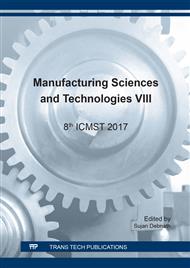p.71
p.77
p.83
p.88
p.95
p.100
p.107
p.112
p.118
Tensile Strength of Sisal/Epoxy Composites Prepared by Vacuum Infusion
Abstract:
Composite systems are materials that due to its characteristics and its achievement of synergistic effects are increasingly applied. The most frequent composites are composites mainly with long fibers. In the interaction with the polymer matrix can be used inorganic fibers, but recently there is a substitution of these fibers with organic fibers. The main advantage of using organic fibers is their low cost, low weight, and availability. The benefits can also cite environmental aspects. The disadvantage is the very nature of the organic material. The paper describes a long-fiber composite system prepared by vacuum infusion and compares the tensile strength of composites with randomly oriented and arranged sisal fibers, depending on the flow direction of the resin during vacuum infusion. Composite systems were cut from boards made by vacuum infusion using a water jet. These boards are widely used by industries such as automotive or building to where the natural fibers can create design function. The use of natural fibers in this process is inexpensive and such materials can be referenced as biocomposites, saving the primary raw material. The paper describes the tensile strength and hardness. Electron microscopy was used to evaluate fracture surfaces and the morphology of the fibers.
Info:
Periodical:
Pages:
95-99
Citation:
Online since:
January 2018
Authors:
Keywords:
Price:
Сopyright:
© 2018 Trans Tech Publications Ltd. All Rights Reserved
Share:
Citation:


